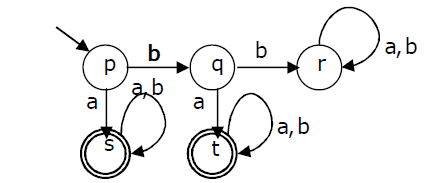Regular languages and finite automata
Question 1
Given the language L = {ab, aa, baa}, which of the following strings are in L*?
Question 2
Consider the languages L1 = [Tex]\\phi [/Tex]and L2 = {a}. Which one of the following represents L1 L2* U L1*
Question 3
Consider the DFA given.
[caption width="800"] [/caption]
[/caption]
Which of the following are FALSE?
Question 4
Consider the set of strings on {0,1} in which, every substring of 3 symbols has at most two zeros. For example, 001110 and 011001 are in the language, but 100010 is not. All strings of length less than 3 are also in the language. A partially completed DFA that accepts this language is shown below.
[caption width="800"] [/caption]
[/caption]
The missing arcs in the DFA are
Question 5
Definition of a language L with alphabet {a} is given as following.
L={|ank|k>0, and n is a positive integer constant}
What is the minimum number of states needed in DFA to recognize L?
Question 6
Question 7
Let w be any string of length n is {0,1}*. Let L be the set of all substrings of w. What is the minimum number of states in a non-deterministic finite automaton that accepts L?
Question 8
Question 10
Given the following state table of an FSM with two states A and B, one input and one output:
| Present State A | Present State B | Input | Next State A | Next State B | Output |
0 | 0 | 0 | 0 | 0 | 1 |
0 | 1 | 0 | 1 | 0 | 0 |
1 | 0 | 0 | 0 | 1 | 0 |
1 | 1 | 0 | 1 | 0 | 0 |
0 | 0 | 1 | 0 | 1 | 0 |
0 | 1 | 1 | 0 | 0 | 1 |
1 | 0 | 1 | 0 | 1 | 1 |
1 | 1 | 1 | 0 | 0 | 1 |
If the initial state is A=0, B=0, what is the minimum length of an input string which will take the machine to the state A=0, B=1 with Output = 1?
There are 154 questions to complete.
 [/caption]
[/caption] [/caption]
[/caption] [/caption]
[/caption] [/caption]
[/caption]

